ASP.NET core 6 Blazor Server Apiを作成する
- 作成日 2022.01.31
- 更新日 2022.02.02
- ASP.NET Core
- ASP.NET Core
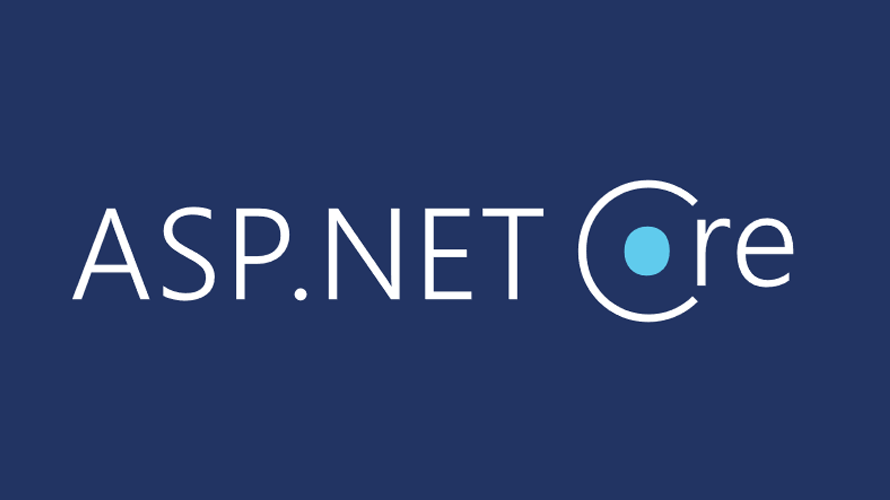
ASP.NET core 6で、Apiを作成する手順を記述してます。.NETのバージョンは6を使用してます。
環境
- OS windows10 pro
- IDE Visual Studio 2022
- .NET 6
- Sql Server 2019
プロジェクト作成
ここでは、「Blazor Server アプリ」を選択してプロジェクトを作成してます。

任意の名前でプロジェクトを作成します。
※ここでは「BlazorApp1」という名前で作成してます。

「.NET6.0」を選択して「作成」ボタンを押下します。

使用するDB
今回、接続するDBの種類は「sql server」で、以下のDB「hoge」内にあるテーブル「member」からモデルを作成します。
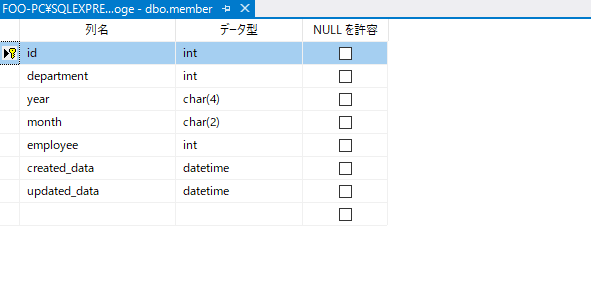
パッケージ追加
事前にパッケージを追加しておきます。「パッケージ マネージャー コンソール」を開きます。
「ツール」 > 「NuGet パッケージ マネージャー」 > 「パッケージ マネージャー コンソール」を選択します。

以下の2つのパッケージを追加しておきます。
PM> Install-Package -ProjectName testBla -Id Microsoft.EntityFrameworkCore.SqlServer
PM> Install-Package -ProjectName testBla -Id Microsoft.EntityFrameworkCore.Toolsモデル作成
パッケージ マネージャー コンソールから、モデルを作成します。
DBへの接続情報は以下となります。
Sql server : 192.168.xxx.xxx
Database : hoge
user : sa
password : password
「Scaffold-DbContext」を使用して作成します。
PM> Scaffold-DbContext -Provider Microsoft.EntityFrameworkCore.SqlServer -Connection "Data Source=192.168.xxx.xxx;Database=hoge;user id=sa;password=password" -f -OutputDir "Data" -Context "sampleDbContext" -UseDatabaseNames -DataAnnotations「Build succeeded.」と表示されれば作成完了です。

| 項目 | 内容 | ここでの設定 |
|---|---|---|
| Provider | Microsoft.EntityFrameworkCore.SqlServer | Microsoft.EntityFrameworkCore.SqlServer “Data |
| Connection | DBに接続するための接続文字列 | Source=192.168.xxx.xxx;Database=hoge;user id=sa;password=password |
| f | 強制的に上書き | |
| OutputDir | モデルを出力するパス | Models |
| Context | コンテキストクラス名 | sampleDbContext |
| UseDatabaseNames | データベースのテーブル名をクラス名にする | |
| DataAnnotations | DataAnnotation属性の自動付与 |
モデル確認
「Data」配下に、作成されていることが確認できます。

「member.cs」
using System;
using System.Collections.Generic;
using System.ComponentModel.DataAnnotations;
using System.ComponentModel.DataAnnotations.Schema;
using Microsoft.EntityFrameworkCore;
namespace BlazorApp1.Data
{
[Table("member")]
public partial class member
{
[Key]
public int id { get; set; }
public int department { get; set; }
[StringLength(4)]
[Unicode(false)]
public string year { get; set; } = null!;
[StringLength(2)]
[Unicode(false)]
public string month { get; set; } = null!;
public int employee { get; set; }
[Column(TypeName = "datetime")]
public DateTime created_data { get; set; }
[Column(TypeName = "datetime")]
public DateTime updated_data { get; set; }
}
}
「sampleDbContext.cs」にはDBへの接続情報が記載されている「OnConfiguring」メソッドがあり警告がでます。これは、削除しておきます。
using System;
using System.Collections.Generic;
using Microsoft.EntityFrameworkCore;
using Microsoft.EntityFrameworkCore.Metadata;
namespace BlazorApp1.Data
{
public partial class sampleDbContext : DbContext
{
public sampleDbContext()
{
}
public sampleDbContext(DbContextOptions<sampleDbContext> options)
: base(options)
{
}
public virtual DbSet<member> members { get; set; } = null!;
// 削除
protected override void OnConfiguring(DbContextOptionsBuilder optionsBuilder)
{
if (!optionsBuilder.IsConfigured)
{
#warning To protect potentially sensitive information in your connection string, you should move it out of source code. You can avoid scaffolding the connection string by using the Name= syntax to read it from configuration - see https://go.microsoft.com/fwlink/?linkid=2131148. For more guidance on storing connection strings, see http://go.microsoft.com/fwlink/?LinkId=723263.
optionsBuilder.UseSqlServer("Data Source=192.168.101.187;Database=hoge;user id=sa;password=password");
}
}
protected override void OnModelCreating(ModelBuilder modelBuilder)
{
modelBuilder.Entity<member>(entity =>
{
entity.Property(e => e.created_data).HasDefaultValueSql("(getdate())");
entity.Property(e => e.month).IsFixedLength();
entity.Property(e => e.updated_data).HasDefaultValueSql("(getdate())");
entity.Property(e => e.year).IsFixedLength();
});
OnModelCreatingPartial(modelBuilder);
}
partial void OnModelCreatingPartial(ModelBuilder modelBuilder);
}
}
接続情報
sqlserverと接続できるように接続情報を用意します。
「appsettings.json」に、以下のコードを追加します。

「ConnectionStrings」を追加します。
{
"Logging": {
"LogLevel": {
"Default": "Information",
"Microsoft.AspNetCore": "Warning"
}
},
"AllowedHosts": "*",
"ConnectionStrings": {
"DefaultConnection": "Server=192.168.xxx.xxx;Database=hoge;User ID=sa;Password=password;"
}
}サービス登録
「Program.cs」に接続情報と「app.MapControllers();」を追加します。
using BlazorApp1.Data;
using Microsoft.AspNetCore.Components;
using Microsoft.AspNetCore.Components.Web;
using Microsoft.EntityFrameworkCore;
var builder = WebApplication.CreateBuilder(args);
// Add services to the container.
builder.Services.AddRazorPages();
builder.Services.AddServerSideBlazor();
builder.Services.AddSingleton<WeatherForecastService>();
// 追加
builder.Services.AddDbContext<sampleDbContext>(
options => options.UseSqlServer(
builder.Configuration.GetConnectionString("DefaultConnection")
)
);
var app = builder.Build();
// Configure the HTTP request pipeline.
if (!app.Environment.IsDevelopment())
{
app.UseExceptionHandler("/Error");
// The default HSTS value is 30 days. You may want to change this for production scenarios, see https://aka.ms/aspnetcore-hsts.
app.UseHsts();
}
app.UseHttpsRedirection();
app.UseStaticFiles();
app.UseRouting();
app.MapBlazorHub();
// 追加
app.MapControllers();
app.MapFallbackToPage("/_Host");
app.Run();
Api作成
「Controllers」フォルダに「スキャフォールディング」を使用して、Controllerを作成します。
「Controllers」フォルダを作成して、右クリックして「新規スキャフォールディングアイテム」をクリックします。
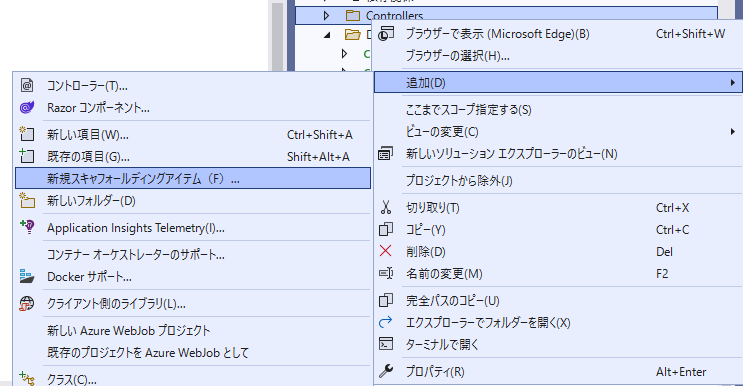
「Entity Frameworkを使用したアクションがある APIコントローラー」を、選択して追加をクリックします。
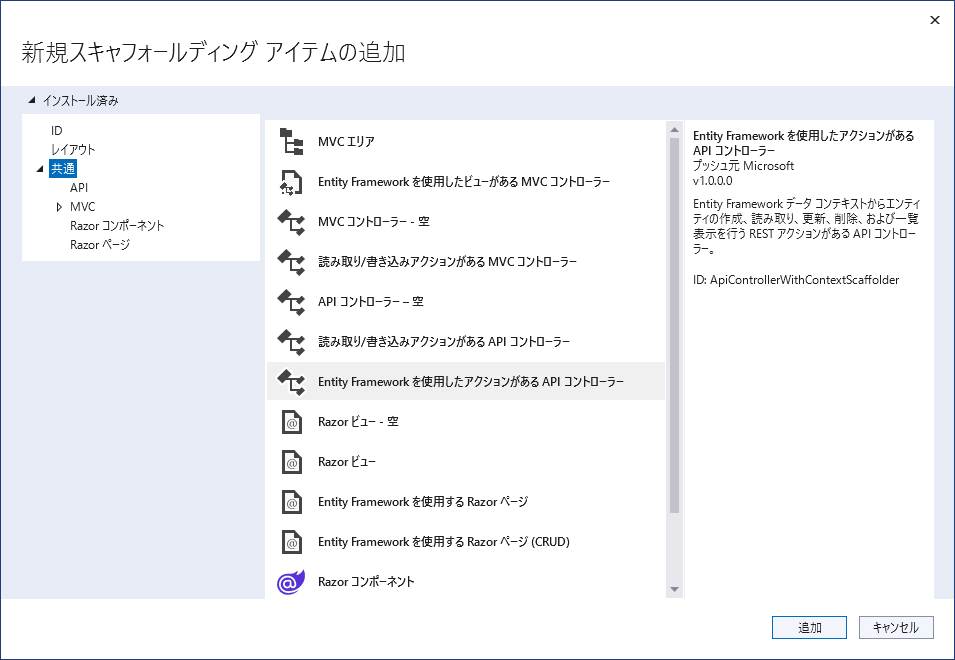
「memberController.cs」という名前を入力して「追加」をクリックします。
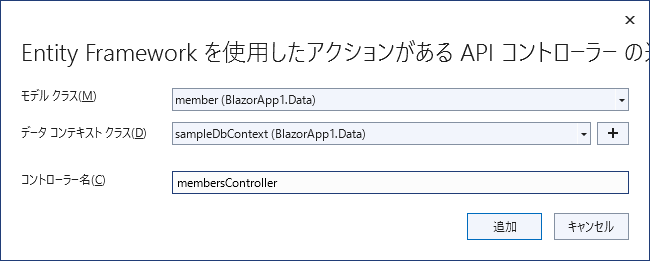
API確認
デバックを実行して「api/t_member」にアクセスするとjsonが表示されていることが確認できます。

-
前の記事

python PySimpleGUIでInputに入力された値をクリアする 2022.01.31
-
次の記事
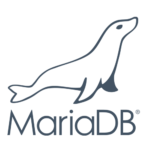
MariaDB バージョンを確認する 2022.01.31






コメントを書く